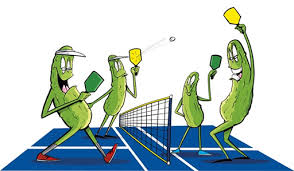We met some of the neighbors yesterday during our first steps inside the shell of our new Florida home. Both were Pickleball enthusiasts, the current rage of resort style living communities. It looks like a game I’ll need to learn if I want to properly fit-in. I would initially describe it as a cross between racquet ball and ping pong, but this is how Wikipedia describes the game: “Pickleball is a paddleball sport that combines elements of badminton, table tennis, and tennis. Two or four players use solid paddles made of wood or composite materials to hit a perforated polymer ball, much like a whiffle ball, with 26-40 round holes, over a net.” Pickle-mania!
“The five rules of pickleball are that the ball must stay inbounds, there should be one bounce per side, serving must be done at the baseline, the serve can’t land in the no-volley zone, and the game ends at 11, 15, or 21 points. The game started during the summer of 1965 on Bainbridge Island, Washington, at the home of Joel Pritchard, who later served in Congress and as lieutenant governor. He and two of his friends, Bill Bell and Barney McCallum, returned from golf and found their families bored one Saturday afternoon. They attempted to set up badminton, but no one could find the shuttlecock. They improvised with a perforated plastic ball, lowered the badminton net, and fabricated paddles of plywood from a nearby shed.”
I thought I would impress the neighbors by learning some of the language of the game:
Around-the-post, ATP is a shot that travels outside the net posts, allowing its trajectory to stay below the height of the net.
Baseline is the line at the back of the pickleball court (22 feet from the net).
Bash is a hard shot that hits the top of the net (i.e. the tape) and then lands in play on the opponent’s side of the court. A bash is typically unintentional and very difficult to return as the ball changes speed and/or direction due to contact with the net.
Carry Hitting the ball in such a way that it does not bounce away from the paddle but tends to be carried along on the face of the paddle. This is a fault.
Centerline The line bisecting the service courts that extends from the non-volley line to the baseline.
Crosscourt The opponent’s court diagonally opposite a player’s.
Dink A dink is a soft shot, made with the paddle face open, and hit so that it just clears the net and drops into the non-volley zone.
Erne A volley hit near the net by a player positioned outside the court or in the process of leaping outside the court. A legally executed erne shot allows a player to hit the ball closer to the net without stepping in the non-volley zone.
Fault An infringement of the rules that ends the rally.
Foot fault Stepping on or into the non-volley zone while volleying a ball, or, while serving, failure to keep both feet behind the baseline with at least one foot in contact with the ground or floor when the paddle contacts the ball.
Half-volley A type of hit where the player hits the ball immediately after it has bounced in an almost scoop-like fashion.
Kitchen The non-volley zone which is seven feet from the net on both sides is commonly referred to as “the kitchen”. Players may not enter the kitchen to return a ball unless the ball first bounces.
Lob Hitting the ball in a high arc to the back of the opponent’s court. Ideally designed to clear an opponent who has advanced toward the net.
Net serve A serve that touches the top of the net and lands in the proper service court (it is replayed without penalty).
Non-volley zone A seven-foot area adjacent to the net within which one may not volley the ball. The non-volley zone includes all lines around it. Also called the “kitchen”.
Poach In doubles, to cross over into one’s partner’s area to make a play on the ball.
Rally Hitting the ball back and forth between opposite teams.
Serve, service An underarm lob or drive stroke used to put a ball into play at the beginning of a point.
Server number When playing doubles, either “1” or “2”, depending on whether one is the first or second server for one’s side. This number is appended to the score when it is called, as in “the score is now 4–2, second server”.
Sideline The line at the side of the court denoting in- and out-of-bounds.
Side-out When the serve moves to the opponent’s side.
Volley To hit the ball before it touches the ground and bounces.
My interpretation of Pickle-mania: Keep out of the kitchen, watch your step, stay in the lines, don’t ever poach or fault, act like dinks or net serves are intentional, and make sure it’s your turn to serve.

Leave a Reply